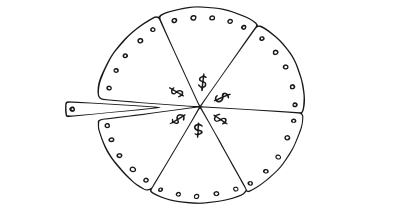Persuasive Patterns: Demonstration, Facilitation
Chaining
Link individual behaviors together into a final, complex action

Chaining is a behavioral technique where individual actions are linked to form a complex behavior sequence, each step triggering the next, leading to a final action or outcome.
A sequence of smaller and easier actions can ultimately lead to a desired, more complex behavior.
The task of organizing your home office can seem daunting at first, but not if you break it down. First, you clear your desk (small, easy step). This initial success motivates you to tackle the overflowing bookshelf next (slightly larger step). Feeling a sense of accomplishment, you move on to sorting through old files (larger step). By chaining these smaller actions together, you’ve completed the overwhelming task of organizing your home office, one manageable step at a time.
Similarly, many e-commerce platforms utilize chaining to guide users towards a purchase. When browsing an online clothing store you might add a dress you like to your cart (small, easy step). This action might trigger a pop-up offering a discount for adding another item (slightly larger step). The ease of adding another item, coupled with the perceived value of the discount, incentivizes you to keep browsing. This chaining of small actions – adding an item, getting a discount, browsing more – can ultimately lead to a larger purchase than initially intended.
Highlighting small wins throughout a process can increase user engagement and completion rates.
The study: Animal behavior chaining
One of the foundational studies exploring the chaining pattern in behavior analysis is the work by Keller and Schoenfeld in 1950. They demonstrated how behaviors could be linked to form complex sequences through a process they termed “behavior chaining.” Their research focused on breaking down tasks into manageable steps where the completion of one step acts as the cue to initiate the next. This principle was originally demonstrated in animal behavior studies, where actions were taught in sequences, showing that even complex behaviors could be learned incrementally.
In one of their experiments, they might train a rat to press a lever to receive food. Once the rat reliably presses the lever, the researchers would introduce a new behavior – such as pulling a chain to get access to the lever. The successful pulling of the chain becomes the cue to press the lever, which in turn, results in getting food. Over time, these linked behaviors form a chain, allowing the rat to perform a sequence of actions that each depend on the completion of the previous action.
This approach showed that complex behaviors do not need to be taught in isolation or all at once. Instead, they can be broken down into manageable components, where mastery of each component leads naturally to the performance of the next, culminating in the ability to perform the entire sequence as a single fluid action.
Keller, F. S., & Schoenfeld, W. N. (1950). Principles of psychology: A systematic text in the science of behavior. Appleton-Century-Crofts.
Chaining is rooted in the principles of operant conditioning, a theory developed by B.F. Skinner, which posits that behaviors followed by positive reinforcement will be more likely to occur in the future, while those followed by negative consequences will be less likely. In chaining, this concept is expanded by linking a series of discrete actions together, each reinforcing the next, to form a complex behavior chain. Each step in the chain acts as a conditioned reinforcer for the previous step and as an antecedent for the next, creating a seamless progression toward a final goal.
Chaining breaks down a target behavior into component parts, which can be analyzed and taught sequentially. This method is particularly useful for teaching new skills by starting with simple tasks and gradually adding complexity.
From an educational perspective, chaining facilitates skill acquisition by allowing learners to build confidence as they master each part of the task. This scaffolding approach supports learning by minimizing frustration and maximizing the sense of achievement as learners progress.
Chaining inherently motivates individuals by providing immediate, small rewards (completion of each step) that cumulatively lead to the achievement of a larger goal. This setup utilizes the principles of incremental reinforcement to maintain engagement throughout the learning or behavior change process.
The study: A small nudge
A group of researchers wanted to understand how habits form. They placed a bucket in a busy university hallway, strategically positioning it next to a table piled with flyers. Over time, they observed a fascinating phenomenon. People walking by initially ignored the bucket. However, if a researcher first crumpled a flyer and tossed it near the bucket, 23% of passersby then proceeded to crumple their own flyer and toss it in as well. This seemingly insignificant act of tossing a crumpled flyer highlights the power of chaining. The initial small step (seeing a crumpled flyer) triggered a chain reaction, making the desired behavior (throwing away a flyer) significantly more likely.
Cialdini, R. B. (1984). Influence: The psychology of persuasion. HarperCollins.
By segmenting complex actions into smaller, logical steps, chaining helps manage cognitive load, making it easier for individuals to process information and perform tasks that would otherwise be too complex or overwhelming.
Chaining, therefore, not only serves as a practical tool for teaching and modifying behavior but also offers a structured approach that taps into fundamental psychological mechanisms such as reinforcement, motivation, and cognitive processing.
Chaining builds on behavioral momentum: once an initial action is taken, subsequent actions become progressively easier to perform. Here’s how it applies to Chaining:
- Reduced aversion
Starting with a small, easy step minimizes the perceived difficulty of the overall task. This reduces the initial resistance or aversion users might feel towards a complex action. - Building confidence
Successfully completing the initial step fosters a sense of accomplishment. This positive reinforcement motivates users to continue down the chain, building confidence in their ability to complete the entire task. - Cognitive anchoring
Our brains tend to anchor onto the first action in a sequence. By making the initial step easy, Chaining sets a positive anchor for the entire process, making it feel more manageable. - Habit formation
Repeatedly completing the steps in a chain can lead to the formation of a habit. Over time, the desired behavior becomes more automatic, requiring less conscious effort.
These psychological mechanisms working in tandem empower Chaining to effectively guide users towards completing complex actions. By breaking down tasks into smaller, achievable steps, Chaining reduces the psychological burden and increases the likelihood of successful completion.
Designing products with Chaining
The chaining technique can be effectively employed to guide users through complex tasks, enhancing user experience by breaking down the tasks into manageable steps. This not only facilitates learning and adoption but also fosters a deeper engagement by making the process achievable and rewarding.
To identify the sequence of user actions that lead to a desired outcome, start by mapping out the user journey in detail, identifying every step the user needs to take from the initial engagement to the final action. This map will serve as the blueprint for designing the user interface and experience.
Once the sequence is laid out, focus on making each step intuitive and easy to execute. Design each user interaction to naturally lead to the next, ensuring a smooth flow that guides the user towards the completion of the task. For example, in a complex software application, introduce users first to basic functionalities before gradually unveiling more sophisticated features. This can be achieved through progressive disclosure techniques where additional options are revealed as the user becomes more proficient.
To enhance the effectiveness of chaining:
- Start small, end big
Break down the desired user journey into a sequence of clear, achievable steps. The initial step should be especially easy to complete. This initial success sets a positive tone and motivates users to progress through the chain. - Visualize the chain
Consider using a progress bar or visual indicators to show users their place within the chain. This not only enhances transparency but also provides a sense of accomplishment as users see themselves progressing towards the final goal. - Provide clear feedback
At each step, provide users with clear feedback to confirm their actions and guide them to the next step. This could be in the form of visual cues, such as highlighting a button after a task is completed, or auditory feedback, such as a sound that denotes a successful action. - Celebrate each step
Acknowledge and celebrate the completion of each step within the chain. Positive reinforcement, even for small wins, keeps users motivated and engaged. Simple design elements like check marks or brief congratulatory messages can be effective. Rewards could range from unlocking new features, providing digital badges, or offering virtual points that can be collected towards a reward - Make it frictionless
Ensure a smooth flow between steps in the chain. This means minimizing loading times, optimizing for different devices, and keeping instructions clear and concise. Frictionless navigation keeps users focused on completing the entire chain. - Simplify the process
Ensure that each step is as simple as possible to avoid overwhelming the user. Complex tasks should be broken down into smaller, easily digestible actions that can be quickly learned and executed. - Personalize the journey
When possible, personalize the chain to the user’s specific needs or goals. This can make the process feel more relevant and engaging. Imagine an onboarding chain that adapts based on the user’s experience level.
Consider including a simple diagram here to visually represent the Chaining process. The diagram could show a sequence of boxes or shapes connected by arrows, with the first box labeled “Start (Small Step)” and the last box labeled “Goal.” Each box in between could represent a step in the chain.
Ethical recommendations
The chaining pattern, while effective in enhancing user engagement and behavior modification, carries potential risks when misused. One such risk is manipulation, where chaining is used to lead users into unwanted or harmful behaviors without clear consent or awareness. This could manifest in applications that progressively encourage users to divulge personal information, spend money, or commit time in ways that do not align with their initial intentions or best interests.
Chaining can be used to exploit user aspirations. Imagine a fitness app that relentlessly chains users through workout routines, neglecting their individual needs or limitations. This can lead to discouragement and ultimately hinder user goals.
While minimizing friction is key in chaining, some implementations might create “friction traps.” Imagine an onboarding process that chains users through numerous steps, each requiring logins or data entry. This excessive friction can frustrate users and cause them to abandon the process altogether.
Another concern is dependency, where the chaining design creates an addictive loop, compelling users to continue interacting with a product or service beyond their practical or emotional benefit. This can be particularly problematic in digital environments like social media platforms or gaming, where prolonged engagement is encouraged without regard to the user’s well-being.
To mitigate these risks and ensure ethical use of the chaining pattern, the following best practices are recommended:
- Be transparent
Clearly inform users about the behavior modification methods being employed, including the intentions behind any chained actions. Users should always have a clear understanding of what they are committing to at each step of the process. - User control and consent
Allow users to have control over their participation in chained activities. This includes easy options to opt out at any stage without penalties or loss of previously accrued benefits. - Beneficial boundaries
Set boundaries that prevent chaining from becoming coercive or overly demanding. This can be achieved by limiting the number of actions required to reach a goal, ensuring the steps are reasonable, and aligning them closely with users’ interests and capacities. - Frictionless flow
Minimize unnecessary steps and optimize the flow between chained actions. Respect user time and effort by ensuring a smooth and efficient journey.
The ultimate goal of chaining should be to enhance user experience, not manipulate behavior. Focus on creating a sequence of steps that genuinely adds value and helps users achieve their goals.
Real life Chaining examples
Codecademy
In teaching programming, Codecademy employs chaining by breaking down complex programming concepts into smaller, manageable exercises that build on each other, helping users grasp intricate coding techniques through a series of steps.
Zoho CRM
Zoho CRM implements chaining by leading new users through a sequence of setup steps when they first sign up. Users are guided from adding basic company information to more detailed steps such as integrating with email and setting up workflow rules, which helps in gradually increasing their comfort level with the software.
MyFitnessPal
This fitness tracking app helps users start their fitness journey by initially setting up a basic profile and then progressively guides them through detailed daily logging of food and exercise. This approach helps users form habits by building the complexity of their tracking activities step-by-step.
Trigger Questions
- What is the complex action we want users to complete?
- Can we break this action down into a sequence of smaller, achievable steps?
- Are the steps logically ordered to build upon each other?
- How can we visually represent progress through the chain?
- What opportunities exist to celebrate user completion of each step?
- Have we minimized friction between steps in the chain?
- Can we personalize the chain based on user needs or goals?
- What rewards or incentives can we introduce to motivate progression through the steps?
- How can we adjust the difficulty of tasks to match user skill levels as they progress?
Pairings
Chaining + Commitment & Consistency
This combination leverages the user’s desire to remain consistent with their past actions. By initially getting users to commit to small tasks through chaining, they are more likely to continue engaging with the product to maintain consistency with their initial commitment. Subscription services use this technique by starting users on small, easy tasks that lead to more regular usage and eventually, loyalty.

Link individual behaviors together into a final, complex action

We want to appear consistent with our stated beliefs and prior actions
Chaining +
Priming
Using priming to set the stage for each step in the chaining process can enhance user performance and perception. By exposing users to specific stimuli or information before they perform a task, you can increase the likelihood that they will perform it more effectively and with greater satisfaction.

Link individual behaviors together into a final, complex action
Chaining + Curiosity Effect
Pairing chaining with the curiosity effect can keep users engaged as they progress through a sequence. By gradually revealing more information and keeping some elements mysterious or unexpected, you can maintain user interest and encourage them through the chain. For example, a learning platform might use teaser content at the end of each lesson to pique curiosity about what’s coming next.

Link individual behaviors together into a final, complex action

We crave more when teased with a small bit of interesting information
Chaining + Limited Choice
Integrating chaining with limited choice can help streamline user decisions, making the process less overwhelming. By reducing the number of options available at each step of the chain, you can guide users more effectively through a predefined path without the paralysis that sometimes accompanies too many choices.

Link individual behaviors together into a final, complex action

We are more likely to make a decision with fewer options to choose from
Chaining + Status
Combining chaining with status levels can motivate users by acknowledging their progress through visible status upgrades. As users complete each link in the chain, they achieve higher status levels, which can unlock new features, benefits, or recognition, enhancing their engagement and loyalty to the product.

Link individual behaviors together into a final, complex action

We constantly look to how our actions improve or impair how others see us
Chaining + Peak-End Rule
This combination ensures that each final step in a chained sequence is memorable and impactful, capitalizing on the psychological principle that people remember the peak and end of an experience most vividly. Designing each chain’s conclusion with a rewarding or emotionally positive experience can significantly affect the overall user satisfaction and retention.

Link individual behaviors together into a final, complex action

We judge an experience by its peak and how it ends
A brainstorming tool packed with tactics from psychology that will help you build lasting habits, facilitate behavioral commitment, build lasting habits, and understand the human mind. It is presented in a manner easily referenced and used as a brainstorming tool.
Get your deck!- The Behavior of Organisms: An Experimental Analysis by Skinner
- Applying Behavior-Analysis Procedures with Children and Youth by Sulzer-Azaroff & Mayer
- Batra, Rajkumar & Ahtola, Olli (2007). The role of emotional branding in building brand loyalty. Journal of Consumer Psychology, 17(3), 210-220.
- Ullman, M. T. (2006). The objective control of behavior in the laboratory. In W. K. Honig (Ed.), Handbook of operant behavior (pp. 57-132). Springer.
- Duhigg, C. (2012). The power of habit: Why we do what we do in life and business. Random House Books.
- Fogg, B. J. (2019). Tiny habits: The small changes that change everything. Houghton Mifflin Harcourt.
- Keller, F. S., & Schoenfeld, W. N. (1950). Principles of psychology: A systematic text in the science of behavior. Appleton-Century-Crofts.
- Skinner, B. F. (1953). Science and Human Behavior. Macmillan.
- Terrace, H. S. (1963). Discrimination learning with and without "errors." Journal of the Experimental Analysis of Behavior, 6(1), 1-27.
- Epstein, R., Kirshnit, C. E., Lanza, R. P., & Rubin, L. C. (1984). 'Insight' in the pigeon: Antecedents and determinants of an intelligent performance. Nature, 308(5954), 61-62.
- Cialdini, R. B. (1984). Influence: The psychology of persuasion. HarperCollins.
- Wood, W., & Neal, D. T. (2007). Habit formation in everyday life: Voluntary versus automatic processes. Journal of Personality and Social Psychology, 92(6), 1307-1324.

